David Blackman: Minoan shipsheds
This article was previously published in “Skyllis” 11.Vol. 2 (2011) pp 411 and is reproduced here by the kind permission of the author.
Minoan shipsheds 1
David Blackman
Abstract – Covered slipways or ‘shipsheds’ were a diagnostic feature of military harbours in the classical world. A new dimension has been added to the subject with the discoveries at Kommos in southern Crete. In the mid-1980s a row of six long, narrow roofed galleries was revealed, dating to the Late Minoan IIIA1-2 period (14th century BC): interpreted as shipsheds, though they lay well inland. Some were slow to accept this interpretation, but have now been convinced that it is plausible by recent similar discoveries at the port of Knossos. At Poros/Katsamba excavations have revealed a row of six long chambers, perpendicular to the coast, which is now 150 m away. The structures were destroyed in the Late Minoan IIIB (early) period (ca. 1320-1250 BC).We thus have two plausible examples ofMinoan ‚storage shipsheds‘, but Minoan parallels for the later ‘covered slipways’ have not been found, except possibly at Gournia. Other possible sites are discussed, and also iconographic evidence. Finds at Kommos and Naxos in Sicily reveal the possible parallel use of haematite on ships as a colouring and possibly also anti-fouling agent, at sites nine centuries apart in date.
Inhalt – Überdachte Hellinge oder Schiffshäuser waren ein Charakteristikum antiker Militärhäfen. Die Entdeckungen im südkretischen Kommos gaben dem Thema eine zusätzliche Dimension.Mitte der 1980er Jahre wurde eine Reihe von sechs langen, schmalen, überdachten Gängen der Periode Spätminoisch IIIA1-2 aus dem 14. Jh. v. Chr. freigelegt und als Schiffshäuser gedeutet, obwohl sie ein Stück landein liegen. Mancheiner zögerte, diese Deutung anzunehmen, hält sie jetzt aber nach ähnlichen neuen Entdeckungen im Hafen von Knossos für plausibel. In Poros/Katsamba wurde eine Reihe von sechs langen, senkrecht zur jetzt 150 m entfernten Küste liegenden Kammern ausgegraben. Der Bau wurde in Spätmin. IIIB (früh), d.h. ca. 1320-1250 v. Chr. zerstört.Wir haben also zwei einleuchtende Beispiele geschlossener minoischer Schiffshäuser, aber minoische Parallelen für die späteren überdachten Hellinge sind außer vielleicht in Gournia noch nicht gefunden worden. Andere mögliche Fundorte und bildliche Hinweise werden diskutiert. Funde in Kommos und Naxos (Sizilien) lassen auf mögliche gleiche Verwendung von Hämatit als Farb- und vielleicht Schutzanstrich von Schiffen an um neun Jahrhunderte getrennten Fundorten schließen.
Since I was a student I have been studying ancient “shipsheds”, covered slipways which lined the shores of most major harbours of the classical world,to house their warships and shelter them from sun and rain when not operational at sea – and a book on the subject is nearly finished2.
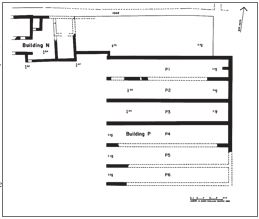
We had envisaged the time limits as being the sixth century BC, when such structures came into use, and the late Roman period; but a new chronological dimension was added to the subject with the discoveries of Joseph Shaw and Maria Shaw, excavating a Minoan site at Kommos on the coast of the Mesara plain in southern Crete (from 1976).
In the mid-1980s a row of six huge long, narrow roofed galleries were gradually revealed from north to south. Building P was 38.51 m from east to west and 39.60 m from north to south, and the individual galleries over 37 m long and 5.44 m wide (Fig. 1); the earliest (P1-2) dated to the Late Minoan IIIA1-2 period (14th century BC) and they continued in use with several phases, including a fire, until they were abandoned by the end of the LM IIIB period (ca 1200 BC). The stone walls were timber-framed, at least in the north, and the floors were of hard-packed earth. The excavators estimate the height as at least 4 m, judging from the amount of masonry fallen in P3; this may be an underestimate. Only P3 has been completely excavated. It also contained hearths and ovens. Distinctive finds were traces of haematite on the floors, and in a bowl, and some of the examples of an unusual type of ‘short-necked amphora’, hardly found outside Kommos, clearly contained haematite.

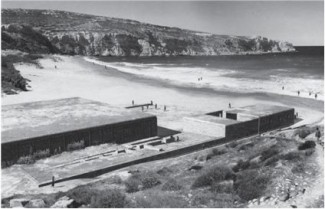
LMIIIB.
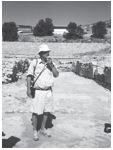
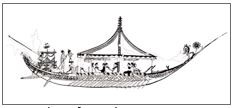
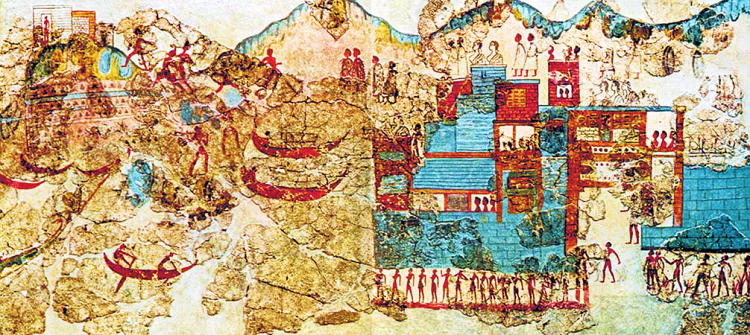
These galleries lie now 80 m from the shore, across an open court, and now 3.30 m above sea level, but with an estimated relative rise in sea level since the LM period they would originally have lain about +5.30-6.30 m above sea level and about 130-150 m from the shore, i.e. set back from the highest reach of waves on this exposed coast (Fig. 2).
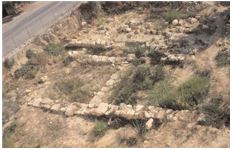
These galleries are not like the storage magazines of Minoan Crete: they are wider, doorless and windowless, closed at the landward end and open at the seaward end (Fig. 3). Already while the excavation was continuing Maria Shaw suggested in 1985 that they could be interpreted as shipsheds, though they lay well inland3, and they have maintained that interpretation in their magnificent site publications. They have, however, remained properly cautious: “[The hypothesis] remains to be proved by the definitive discovery of sufficient nautical equipment connected with such galleries” (Fig. 4).
Some, including the writer, were slow to accept this hypothesis, but have been convinced that it is plausible by recent similar discoveries at the port of Knossos, and by new interpretations of the use of haematite, both of which I shall describe; but I must express the proviso that here the word ‘shipsheds’ means ‘sheds for ship storage’, for example for winter storage well away from the shore, rather than ‘covered slipways’ such as we know in later periods. Such a haulage procedure would have happened only once a year, and we can see ships drawn up on shore in the miniature fresco from Thera (Fig. 5)4.
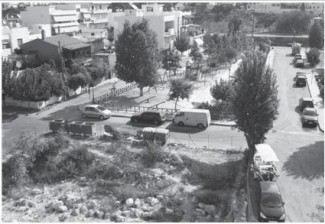
This discovery has raised lively debates about the role of Kommos and the use of the galleries. The commercial importance of Kommos in the Late Minoan period has been made clear by the excavations: does this mean that the shipsheds were for merchant ships or for warships?
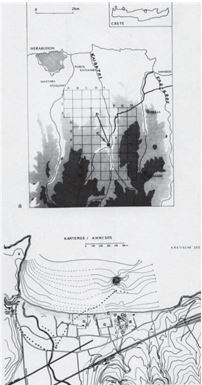
ports; plan of Amnisos.
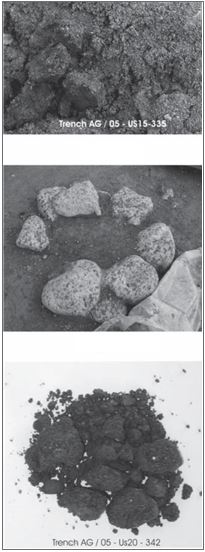
shipsheds.
The galleries have dimensions very similar to those of the Athenian trireme, and the Thera frescoes have shown us long ships which seem to be warships (Fig. 6). Or did the galleries house shorter merchant ships, perhaps two?5 Was Kommos the port of Phaistos and later Haghia Triada?6 It is clear that Kommos was important for the sea route to Egypt.
A promising parallel for the Minoan ‘shipsheds’ at Kommos has recently been discovered on the north coast of Crete at Poros/ Katsamba, the port of Minoan Knossos: excavations by Antonis Vasilakis have revealed a row of six long chambers, three on either side of a narrow passage, running north/south, perpendicular to the coast, which is now 150 m away (Fig. 7)7.
They have an average clear width of 6 m and a surviving length of 21-25 m; neither their back wall nor their seaward end have yet been defined, but the excavator estimates an original length of 45-50 m and that there would have been space for up to five plus five chambers, taking into account the space available as far as the west bank of the river Kairatos (Fig. 8).
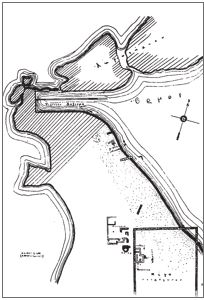
The excavator suggests that the remains found of pottery, raw materials (including pigments) and tools may eventually indicate the activities carried out within the chambers (shipbuilding or repair?). The structures were in use in the Late Minoan II-IIIA periods and were destroyed in the Late Minoan IIIB (Early) period, with the final destruction of the Palace of Knossos (ca. 1320-1250 BC). This find confirms the view of Sir Arthur Evans that here lay the harbour town of Knossos, and we thus have a plausible parallel for Minoan ‘storage shipsheds’8.Recent interesting exchanges of information between the excavators of Kommos (Shaw and Shaw) and Naxos (Blackman and Lentini) have revealed the possible parallel use of haematite as a colouring and possibly also anti-fouling agent for painting on ships at sites nine centuries apart in date At Kommos it was found on the interior of fourteenth-century BC ‘short-necked amphorae ‘ in Building P and on the earthen floor of galleries in that building; at Sicilian Naxos it was found on the inner walls of transport amphorae lying broken in the shipsheds, and also dropped on the ramps and side-passages of the fifth-century shipsheds (Fig. 9).
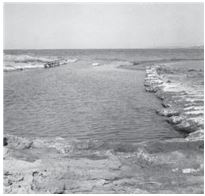
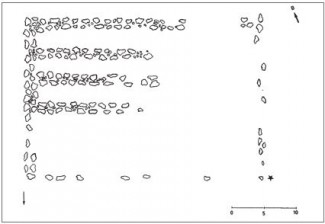
Use in painting ships is clear, and use for protection against e.g. the teredo is likely9. The British Museum Laboratory Report on the Naxos samples says that “they are likely to be made of a mixture of Haematite [iron oxide] and red lead [leadoxide or minium]”: the latter, at least, had biocidal properties. Haematite may have been used more for decoration10.
What other remains of possible harbour installations need to be taken into account? Going east along the north coast of Crete from Herakleion, one arrives almost at once at Amnisos, at the mouth of the river Karteros, which has a claim to have been at least one of the ports of Knossos (Fig. 10); submerged buildings can be seen on the shore and offshore island, but no remains are identifiable as harbour installations11.
The rock-cut basin at Nirou Khani (Figs. 11-12) cannot be regarded as a certain parallel12. Spyridon Marinatos explored a peninsula, which had a large rectangular basin cut in its side, over 46 m long, with three parallel compartments 4.45 to 5 m wide. The southern one lies just above sea level, but the other two are submerged at least 1.8 m. They could possibly be docks, but not slipways, and if one allows for 2-3 m of sea level rise, they were neither. Being rock cuttings they are undatable, but may be Minoan13.
As Shaw has pointed out, Cretan shores are very exposed, but sometimes an offshore islet will have provided some protection: this was the case at Amnisos, Nirou Khani – and also Kommos. Further east at Malia, remains of a storage building with at least 3 parallel walls have been brought into the discussion (Fig. 13). But with any likely relative sea level rise, these are remains of a storage building on land, not directly connected with the shore14.
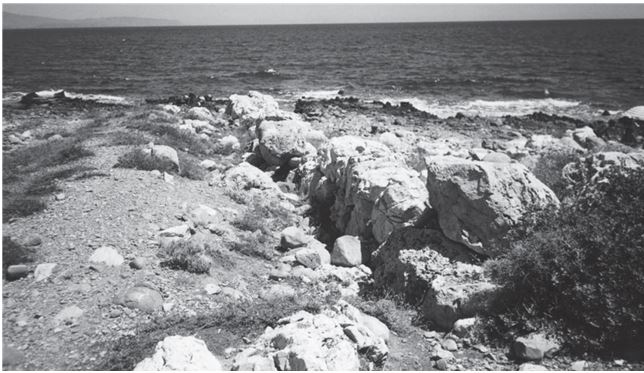
Minoan parallels for the later ‘covered slipways ‘ have not been found, unless one accepts some remains on the shore at Gournia. First noted as the ‘Shore House ‘ and partially excavated by Harriet Boyd Hawes on her first visit to the site in 1901, they have recently been investigated by Vance Watrous. He interprets the remains as a shipshed with two large galleries running northward out to sea with walls of ‘specially chosen limestone boulders ‘, measuring at least 25 m north-south and 10 m east-west (the pair) (Fig. 14). Watrous dates the shipshed construction to roughly the same time as the palace, probably in MMIIIA.He suggests that the galleries were probably destroyed by the effects of the Theran eruption. North of the shipshed, the bedrock promontory juts out to sea, with holes cut into its edge to serve as mooring points for ships. The walls seem to continue some way into the water, so that we may here have a predecessor of the slipways of Classical times. No evidence for roofing has been published. It remains a rather exposed site, which leaves me with some lingering doubts15.
So much for archaeological evidence so far adduced. One must also consider the possible iconographic evidence. For me the only plausible evidence is a structure in the LM IA fresco from the West House at Thera (Fig. 15)16. It lies on the shore, and its facade seems to indicate deep rooms behind. Other possible depictions of shipsheds have been proposed in the frescoes at Thera and Kea, but do not convince me17. We do have in Theran frescoes indications of quays, and ships beached on shore.
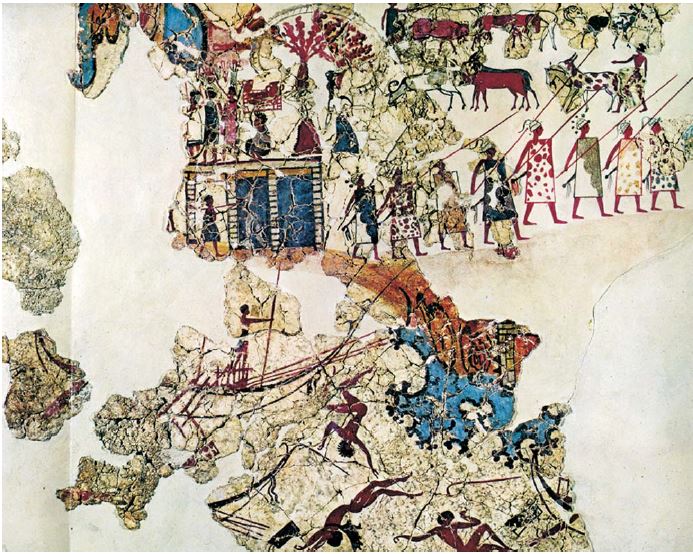
By the fourteenth century or even earlier Minoan mariners visited the Nile delta, and would have become aware of achievements in harbour construction at sites like Tell el-Dab’a18: exchange did not occur only at the level of rich gifts, but also of practical information between seafarers. These, however, were riverine harbours – off-river basins – which derived more from the riverine traditions of navigation and harbour construction in Egypt, Mesopotamia and the Levant, and were not very relevant to the exposed coasts of Crete. The protection provided by offshore islands should not be exaggerated. Hauling warships up the shore, or merchant ships without their cargoes, must have been the normal practice in Crete, with winter storage in storerooms – which form an interesting addition to our growing understanding of the development of the Minoan architectural tradition.
Since I was a student I have been studying ancient “shipsheds”, covered slipways which lined the shores of most major harbours of the classical world, to house their warships and shelter them from sun and rain when not operational at sea – and a book on the subject is nearly finished2. We had envisaged the time limits as being the sixth century BC, when such structures came into use, and the late Roman period; but a new chronological dimension was added to the subject with the discoveries of Joseph Shaw and Maria Shaw, excavating a Minoan site at Kommos on the coast of the Mesara plain in southern Crete (from 1976).
In the mid-1980s a row of six huge long, narrow roofed galleries were gradually revealed from north to south. Building P was 38.51 m from east to west and 39.60 m from north to south, and the individual galleries over 37 m long and 5.44 m wide (Fig. 1); the earliest (P1-2) dated to the Late Minoan IIIA1-2 period (14th century BC) and they continued in use with several phases, including a fire, until they were abandoned by the end of the LM IIIB period (ca 1200 BC). The stone walls were timber-framed, at least in the north, and the floors were of hard-packed earth. The excavators estimate the height as at least 4 m, judging from the amount of masonry fallen in P3; this may be an underestimate. Only P3 has been completely excavated. It also contained hearths and ovens. Distinctive finds were traces of haematite on the floors, and in a bowl, and some of the examples of an unusual type of ‘short-necked amphora’, hardly found outside Kommos, clearly contained haematite.
These galleries lie now 80 m from the shore, across an open court, and now 3.30 m above sea level, but with an estimated relative rise in sea level since the LM period they would originally have lain about +5.30-6.30 m above sea level and about 130-150 m from the shore, i.e. set back from the highest reach of waves on this exposed coast (Fig. 2). These galleries are not like the storage magazines of Minoan Crete: they are wider, doorless and windowless, closed at the landward end and open at the seaward end (Fig. 3). Already while the excavation was continuing Maria Shaw suggested in 1985 that they could be interpreted as shipsheds, though they lay well inland3, and they have maintained that interpretation in their magnificent site publications. They have, however, remained properly cautious: “[The hypothesis] remains to be proved by the definitive discovery of sufficient nautical equipment connected with such galleries” (Fig. 4).
Some, including the writer, were slow to accept this hypothesis, but have been convinced that it is plausible by recent similar discoveries at the port of Knossos, and by new interpretations of the use of haematite, both of which I shall describe; but I must express the proviso that here the word ‘shipsheds’ means ‘sheds for ship storage’, for example for winter storage well away from the shore, rather than ‘covered slipways’ such as we know in later periods. Such a haulage procedure would have happened only once a year, and we can see ships drawn up on shore in the miniature fresco from Thera (Fig. 5)4.
This discovery has raised lively debates about the role of Kommos and the use of the galleries. The commercial importance of Kommos in the Late Minoan period has been made clear by the excavations: does this mean that the shipsheds were for merchant ships or for warships? The galleries have dimensions very similar to those of the Athenian trireme, and the Thera frescoes have shown us long ships which seem to be warships (Fig. 6). Or did the galleries house shorter merchant ships, perhaps two?5 Was Kommos the port of Phaistos and later Haghia Triada6 It is clear that Kommos was important for the sea route to Egypt.
A promising parallel for the Minoan ‘shipsheds’ at Kommos has recently been discovered on the north coast of Crete at Poros/ Katsamba, the port of Minoan Knossos: excavations by Antonis Vasilakis have revealed a row of six long chambers, three on either side of a narrow passage, running north/south, perpendicular to the coast, which is now 150 m away (Fig. 7)7. They have an average clear width of 6 m and a surviving length of 21-25 m; neither their back wall nor their seaward end have yet been defined, but the excavator estimates an original length of 45-50 m and that there would have been space for up to five plus five chambers, taking into account the space available as far as the west bank of the river Kairatos (Fig. 8). The excavator suggests that the remains found of pottery, raw materials (including pigments) and tools may eventually indicate the activities carried out within the chambers (shipbuilding or repair?). The structures were in use in the Late Minoan II-IIIA periods and were destroyed in the Late Minoan IIIB (Early) period, with the final destruction of the Palace of Knossos (ca. 1320-1250 BC). This find confirms the view of Sir Arthur Evans that here lay the harbour town of Knossos, and we thus have a plausible parallel for Minoan ‘storage shipsheds8.
Recent interesting exchanges of information between the excavators of Kommos (Shaw and Shaw) and Naxos (Blackman and Lentini) have revealed the possible parallel use of haematite as a colouring and possibly also anti-fouling agent for painting on ships at sites nine centuries apart in date. At Kommos it was found on the interior of fourteenth-century BC ‘short-necked amphorae ‘ in Building P and on the earthen floor of galleries in that building; at Sicilian Naxos it was found on the inner walls of transport amphorae lying broken in the shipsheds, and also dropped on the ramps and side-passages of the fifth-century shipsheds (Fig. 9). Use in painting ships is clear, and use for protection against e.g. the teredo is likely9. The British Museum Laboratory Report on the Naxos samples says that “they are likely to be made of a mixture of Haematite [iron oxide] and red lead [leadoxide or minium]”: the latter, at least, had biocidal properties. Haematite may have been used more for decoration10.
What other remains of possible harbour installations need to be taken into account? Going east along the north coast of Crete from Herakleion, one arrives almost at once at Amnisos, at the mouth of the river Karteros, which has a claim to have been at least one of the ports of Knossos (Fig. 10); submerged buildings can be seen on the shore and offshore island, but no remains are identifiable as harbour installations11.
The rock-cut basin at Nirou Khani (Figs. 11-12) cannot be regarded as a certain parallel12. Spyridon Marinatos explored a peninsula, which had a large rectangular basin cut in its side, over 46 m long, with three parallel compartments 4.45 to 5 m wide. The southern one lies just above sea level, but the other two are submerged at least 1.8 m. They could possibly be docks, but not slipways, and if one allows for 2-3 m of sea level rise, they were neither. Being rock cuttings they are undatable, but may be Minoan13;.
As Shaw has pointed out, Cretan shores are very exposed, but sometimes an offshore islet will have provided some protection: this was the case at Amnisos, Nirou Khani – and also Kommos. Further east at Malia, remains of a storage building with at least 3 parallel walls have been brought into the discussion (Fig. 13). But with any likely relative sea level rise, these are remains of a storage building on land, not directly connected with the shore14.
Minoan parallels for the later ‘covered slipways ‘ have not been found, unless one accepts some remains on the shore at Gournia. First noted as the ‘Shore House ‘ and partially excavated by Harriet Boyd Hawes on her first visit to the site in 1901, they have recently been investigated by Vance Watrous. He interprets the remains as a shipshed with two large galleries running northward out to sea with walls of ‘specially chosen limestone boulders ‘, measuring at least 25 m north-south and 10 m east-west (the pair) (Fig. 14). Watrous dates the shipshed construction to roughly the same time as the palace, probably in MMIIIA.He suggests that the galleries were probably destroyed by the effects of the Theran eruption. North of the shipshed, the bedrock promontory juts out to sea, with holes cut into its edge to serve as mooring points for ships. The walls seem to continue some way into the water, so that we may here have a predecessor of the slipways of Classical times. No evidence for roofing has been published. It remains a rather exposed site, which leaves me with some lingering doubts15;.
So much for archaeological evidence so far adduced. One must also consider the possible iconographic evidence. For me the only plausible evidence is a structure in the LM IA fresco from the West House at Thera (Fig. 15)16. It lies on the shore, and its facade seems to indicate deep rooms behind. Other possible depictions of shipsheds have been proposed in the frescoes at Thera and Kea, but do not convince me17. We do have in Theran frescoes indications of quays, and ships beached on shore.
By the fourteenth century or even earlier Minoan mariners visited the Nile delta, and would have become aware of achievements in harbour construction at sites like Tell el-Dab’a18: exchange did not occur only at the level of rich gifts, but also of practical information between seafarers. These, however, were riverine harbours – off-river basins – which derived more from the riverine traditions of navigation and harbour construction in Egypt, Mesopotamia and the Levant, and were not very relevant to the exposed coasts of Crete. The protection provided by offshore islands should not be exaggerated. Hauling warships up the shore, or merchant ships without their cargoes, must have been the normal practice in Crete, with winter storage in storerooms – which form an interesting addition to our growing understanding of the development of the Minoan architectural tradition.
Notes
1 I am grateful to many colleagues for providing information, as yet unpublished articles, and/or comments on the draft of this paper: Thomas Guttandin,Maria Costanza Lentini, Johann Mόller, Gerhard Plath, Joseph and Maria Shaw, Aleydis Van de Moortel, Antonis Vasilakis, Alexandra Villing and Vance Watrous; also to Ian Cartright for help with the illustrations. 2 Blackman – Rankov (forthcoming).
3 Shaw 1985; Shaw – Shaw 2006, 851-852 and n. 12, giving full bibliography.
4 Shaw – Shaw 2006, 852, quoting also Homer, Ilias 1.485-486; for the fresco: Marinatos 1974, colour pl. 9. It is worth noting that even in the classical period shipsheds and storerooms could be of very similar dimensions, causing problems of identification, e.g. at Rhodes. See the discussion by J.W. Shaw (1986, 263-268 with fig. 11).
5 Thomas Guttandin and Gerhard Plath have produced some fine reconstruction drawings, which unfortunately have not been published. Granted the high length:breadth ratio of the sheds, they suggest that they each held several ships – an idea already advanced by M.C. Shaw (1985), who favours the idea of merchant ships in the sheds. Guttandin and Plath presented a model in the fine exhibition Inseln der Winde, held in Heidelberg in 2010-2011 (see Plath 2011, 150-157). They now prefer to show Building T, because its earlier date fits that of the Thera ship depictions; I, like the Shaws, believe that only the later Building P can be interpreted as shipsheds.
6 For a recent discussion of the relationship of the sites see Plath 2011, 150-152; and forthcoming. For the development of trade via Kommos with the Eastern Mediterranean, already from the Early Palace Period, see Shaw – Shaw 2006; Van de Moortel (2007) refers to Building AA, replaced by Building T early in the New Palace Period, and suggests that it may have functioned as a caravanserai – as also the later Buildings T, and then P. 11. Fig. 15: Thera fresco (West House, Room 5, Miniature Frieze): depiction of shipshed (?).
7 I am grateful to A. Vasilakis for an advance copy of his preliminary report, now published: Vasilakis 2010. See also Archaeological Reports 2006-7, 109.
8 Evans 1928, 238. 253-255. For Linear B evidence for ships and harbours see Palaima 1991, 308.
9 Shaw – Shaw 2006, 76, 78, 82, pl.38d, 851: „At least part of the explanation of P’s function(s) lies in the use of these transport amphoras“; Shaw – Shaw 2010, 548; Blackman – Lentini 2006, 196-197; Lentini – Savelli – Blackman 2005/6, 100; Lentini et al. 2008, 349-350, figs 49-51 and references there; Lentini – Blackman 2010, 41- 42 and figs 11-12. The remains of pigments from Katsamba have not yet been studied. The same substance has been found on Ship C at Pisa (first century BC/AD: Colombini et al. 2003), and contained in amphorae on a Roman wreck discovered off Mljet in Croatia (Radi΄c-Rossi 2005). Archaic Fikellura amphorae containing red pigment are reported from Kalabaktepe, Miletos, by Frank Wascheck, but not in a maritime context [samples were analysed in the same BM Laboratory programme as the Naxos samples: Alexandra Villing: personal communication].
10 The BM Laboratory and J. Mόller (pers. comm.) are firm that haematite is not biocidal; contra J. Gifford, in: Shaw, J.W. – Shaw, M.C. (eds.) 1996: Kommos I. 2 (Princeton N.J.) 85. We are in the hands of the experts. A. Villing (pers. comm.) wonders whether the mixture in the Naxos red pigments was deliberate.
11 Shaw 1990, 425: indication of a relative sea level rise of 3 m; Schδfer 1991; Niemeyer and Schδfer in Schδfer – Alexiou et al. 1992, 345-348, arguing the case for Amnisos rather than Katsamba as the harbour town of Knossos. Ancient sources support either interpretation, but the new finds from Poros/Katsamba are significant. [The caption to Schδfer’s map and plan (1991, pl. XXVIII) reads: „(a) The Knossos region [with the] addition of ‘Kairatos ‘, ‘Karteros ‘ and possible Minoan routes to Katsamba and Amnisos; (b) Amnisos (Karteros) 1985. Dotted line: Hypothetical coast-line in the 2nd millennium B.C.“ = Fig. 10].
12 References for these sites (also inspected by Blackman): Shaw – Shaw 2006, 851- 852 and n. 16. They also adduce the LMIA fresco from the West House at Thera; this remains open for debate (see below).
13 Gerhard Plath claims to have seen more (pers. comm.); cf. Bφttcher – Plath 2003 [a publication not readily available]. Chryssoulaki (2005, 83) is also more positive.We hope that Plath will publish his important recent observations.
14 Guest-Papaminoli – Treuil 1979; 1980; Shaw 1990, 427-428 with full bibliography, to which add Hue – Pelon 1991, contra. I share Shaw’s doubts (and would add that the compartments do not seem to be fully open at the east end), but cannot help thinking that one could expect something at Mallia similar to what we now know from ports near other palaces. Raban (1983, 239; 1991, 139-140) reviewed the evidence in the light of his work on Canaanite harbours.
15 Hawes et al. 1908, 19; Fotou 1993, 98, pls XX-XXI; Shaw – Shaw 2006, 852 and n.16 (p. 876), with greater doubts;Watrous 2010. I am grateful to Prof.Watrous for permission to show a still unpublished plan, and remember with pleasure walking the site with him a decade ago. I am keen to know the gradient of the structure.
16 Proposal of Maria Shaw: 1985, 23 pl. IIIb; cf.Marinatos 1974, colour pl.7.
17 For example, the proposal by Stucchi (1976, 39), rightly rejected by Shaw (1990, 433), or the building on the ‘Master Impression’ (Hallager 1983), whose doors/ gates are separated from the sea by a band of rocks which would have been an insuperable obstacle.
18 Bietak 2010, 13-16 with figs 2.3-2.5; and bibliography there. On early harbourworks see Blackman 1982, 90-94.When shipsheds were created in Crete in the classical period they were rock-cut in protected positions or bays, such as Matala, Rethymno and Siteia.
Bibliography
Bietak, M. 2010: Minoan presence in the pharaonic naval base of Peru-nefer, in: Krzyszkowska, O. (ed.), Cretan Offerings: Studies in honour of Peter Warren. BSA Studies 18, 11-24. Blackman, D. J. 1982: Ancient harbours in the Mediterranean, Parts 1 and 2, Internat. Journal of Nautical Archaeology 11, 79- 104, 185-211.
Blackman, D. J. 2008: Sea Transport, Part 2: Harbors, in: Oleson, J.P. (ed.), Oxford Handbook of Engineering and Technology in the Classical World, Chapter 25, 638-670 (Oxford).
Blackman, D. J. – Lentini, M. C. 2006: An Ancient Greek Dockyard in Sicily, in: Hafner, A. – Niffeler, U.– Ruoff, U. (eds), Die neue Sicht. Une nouvelle interpretation de l’histoire. The New View, Unterwasserarchäologie und Geschichtsbild. Akten des 2. Internat. Kongresses für Unterwasserarchäologie, Rüschlikon bei Zürich 2004. Antiqua 40 (Basel) 193-197.
Blackman, D. J. – Lentini, M. C. 2010 (eds): Ricoveri per Navi Militari nei Porti del Mediterraneo antico e medievale. Collana CUEBC Ravello: Archeologia, storia, cultura, 5 (Bari).
Blackman – Rankov (forthcoming) =
Blackman, D.J . – Rankov, N. B. – Baika, K. – Gerding, H. – McKenzie, J. – Pakkanen, J.: Shipsheds of the Ancient Mediterranean (Cambridge).
Böttcher, M. – Plath, G. 2003: The harbour installations of Nirou Chani, in: Eisigiseis sto Trito Panellenio Synedrio Limenikon Ergon (Athinai) 381-386.
Chryssoulaki, S. 2005: The imaginary navy of Minoan Crete: rocky coasts and probable harbours, in: Laffineur, R. – Greco, E. (eds), Emporia: Aegeans in the Central and Eastern Mediterranean. Aegaeum 25 (Liège/Austin) 77-90.
Colombini, M. P. – Giachi, G. et al. 2003: The characterisation of paints and waterproofing materials from the shipwrecks found at the archaeological site of the Etruscan and Roman harbour of Pisa (Italy), Archaeometry 45, 659-674.
Evans, A. 1928: The Palace of Minos at Knossos, vol. II (London).
Fotou, V. 1993: New light on Gournia. Aegaeum 9 (Liège/Austin).
Guest-Papaminoli, A. – Treuil, R. 1979: Bâtiment immergé, Bull. de Correspondence Hellénique, Chronique 103, 668-669.
Guest-Papaminoli, A. – Treuil, R. 1980: Discovery of an important building in the sea at Malia, Crete, Archaiologika Analekta ex Athinon 13, 99-101 (in Greek).
Guttandin, T. – Panagiotopoulos, D. – Pflug, H. – Plath, G. (eds) 2011: Inseln der Winde: Die maritime Kultur der bronzezeitlichen Ägäis. Begleitbuch zur Ausstellung (Heidelberg).
Hallager, E. 1983: The Master Impression: a clay sealing from the Greek-Swedish excavations at Kastelli, Khania
(Göteborg). 10 Minoan shipsheds · D. Blackman
Hawes, H. Boyd et al. 1908: Gournia, Vasiliki and Other Prehistoric Sites on the Isthmus of Hierapetra (Philadelphia).
Hue, M. – Pelon, O. 1991:Mallia et la mer, in: Laffineur – Basch 1991, 117-127.
Laffineur, R. – Basch, L. 1991 (eds): Thalassa:L’Égée préhistorique et la Mer.Aegaeum 7 (Liège).
Lentini, M. C. – Savelli, S. – Blackman, D. J. 2005/6: Amphorae from the slipways of the ancient dockyard of Naxos in Sicily, SKYLLIS 7, 2005/6, 94-102.
Lentini et al. 2008 = Lentini, M. C. – Blackman, D. J. – Pakkanen, J. 2008: The shipsheds of Sicilian Naxos: a second preliminary report (2003-2006), Annual of the British School at Athens 103, 317-390.
Lentini, M. C. – Blackman, D. J. 2010: Ultime ricerche nell’arsenale di Naxos di Sicilia, in: Blackman – Lentini 2010, 37-54. Marinatos, S. 1926: Excavations at Nirou Khani, Crete, Praktika, 141-147.
Marinatos, S. 1974: Excavations at Thera, vol. VI (Athens).
Palaima, T. G. 1991: Maritime matters in the Linear B tablets, in: Laffineur – Basch 1991, 273-310.
Plath, G. (forthcoming): The correlations of Kommos and Agia Triada under aspect of coastal alterations, in: Tzalas, H. (ed.), Tropis X, 10th Internat. Symposium on Ship Construction in Antiquity, Hydra 2008.
Plath, G. 2011: Die Hafenstätte von Kommos, in: Guttandin et al. 2011, 150-157. Raban, A. 1983: Recent maritime archaeological research in Israel, Internat. Journal of Nautical Archaeology 12, 229-251.
Raban, A. 1991:Minoan and Canaanite harbours, in: Laffineur – Basch 1991, 129-146.
Radi´c-Rossi, I. 2005: The Mljet shipwreck, Croatia: Roman glass from the sea, Minerva 16.3, 33-35.
Schäfer, J. 1991: Amnisos – Harbour Town of Minos?, in: Laffineur – Basch 1991, 111-116.
Schäfer, J. – Alexiou, S. et al. 1992: Amnisos nach den archäologischen, historischen und epigraphischen Zeugnissen des Altertums und der Neuzeit (Berlin).
Shaw, J. W. 1986: Excavations at Kommos (Crete) during 1984-1985, Hesperia 55, 219-269.
Shaw, J. W. 1990: Bronze Age Aegean Harboursides, in: Hardy, D.A. – Doumas, C.G. et al. (eds), Thera and the Aegean World, III, vol.1 (London) 420-437.
Shaw, J. W. – Shaw, M. C. (eds) 1985: A Great Minoan Triangle in Southcentral Crete: Kommos, Hagia Triada, Phaistos. Scripta Mediterranea 6 (Toronto).
Shaw, J. W. – Shaw, M. C. 1999: A proposal for Bronze Age shipsheds in Crete, in: Tzalas, H. (ed.), Tropis V, 5th Internat. Symposium on Ship Construction in Antiquity, Nauplia 1993, Proceedings (Athens) 369-382.
Shaw, J. W. – Shaw, M. C. 2006: Kommos V: The Monumental Minoan Buildings at Kommos (Princeton/Oxford).
Shaw, J. W. – Shaw, M. C. 2010: Kommos, in: Cline, E.H (ed.), The Oxford Handbook of the Bronze Age Aegean (Oxford) 543-555.
Shaw, M. C. 1985: Late Minoan I building J/T, and Late Minoan buildings N and P at Kommos: Their nature and possible uses as residences, palaces, and/or emporia, in: Shaw – Shaw 1985, 19-25.
Stucchi, S. 1976: Il Giardino delle Esperidi e le tappe della conoscenza greca della costa cirenaica, Quaderni di archeologia della Libia 8, 19-73.
Van de Moortel, A. 2007: The harbour of Kommos and its East Mediterranean Connections in the Protopalatial Period, in: Betancourt, P.P. – Nelson, M.C. – Williams, E.H. (eds), Krinoi kai Limenes: Studies in Honor of Joseph and Maria Shaw (Philadelphia) 177-184.
Vasilakis, A. 2010: Late Minoan shipsheds in Katsamba (Heraklion), in: Andrianakis, M. – Tzachili, I. (eds), Archaiologiko Ergo Kritis I (Rethymno, 28-30 Nov. 2008) 285- 293 (in Greek).
Watrous, L.V. 2010: The Harbor of Gournia: Fieldwork in 2008-2009, Kentro 13, Fall 2010, 12-14.
Credits of figures
Fig. 1: Kommos V, 961 pl. 1.11;
Fig. 2: Kommos V, Frontispiece;
Fig. 3: Kommos V, 962 pl.1.12;
Fig. 4 and 14: DJB photo, 2001;
Fig. 5-6: Marinatos 1974: colour pl. 9;
Fig. 7-8: DJB photo, 2008;
Fig. 9: Lentini et al. 2008 figs 49-51;
Fig. 10: Schδfer 1991, pl. XXVIII;
Fig. 11: Marinatos 1926;
Fig. 12: DJB photo, 1964;
Fig. 13: after Guest – Papaminoli 1979, fig.3;
Fig. 15: Marinatos 1974: colour plate 7. Address David Blackman CSAD, Ioannou School of Classical Studies 66 St Giles’ Oxford OX1 3LU United Kingdom david.blackman@classics.ox.ac.uk

Leave a Reply
You must be logged in to post a comment.